Summary
Informed Consent requires that a patient be told they are being experimented on and the patient must be told and must understand all the risks.
Legal Action Today
- This firm is fighting mandatory COVID-19 vaccines with legal filings and warnings
- In December, the U.S. Equal Employment Opportunity Commission offered its guidance. The EEOC said employers can require their employees to get COVID-19 vaccinations as a condition of going to work, as long as there are reasonable accommodations for those who decline because of a disability or religious beliefs.
- In an interview with the Washington Post, Kennedy pointed to a 1905 U.S. Supreme Court decision, Jacobson v. Massachusetts, which upheld the power of state government to force residents to get vaccinated against smallpox or pay a fine. To succeed, “you’d need to go to the Supreme Court and get a reversal of Jacobson,” he said.
- Senator Ted Cruz is introducing a bill to strengthen individual liberty with regards to vaccines, since otherwise people can effectively be vaccinated. However, this bill doesn’t go far enough.
Informed Consent Laws
Electronic Code of Federal Regulations (e-CFR) –> Title 21 – Food and Drugs –> CHAPTER I – FOOD AND DRUG ADMINISTRATION, DEPARTMENT OF HEALTH AND HUMAN SERVICES –> SUBCHAPTER A – GENERAL –> PART 50 – PROTECTION OF HUMAN SUBJECTS –> Subpart B – Informed Consent of Human Subjects –> § 50.25 Elements of informed consent.
21 CFR § 50.25 – Elements of informed consent
(a) Basic elements of informed consent. In seeking informed consent, the following information shall be provided to each subject:
(1) A statement that the study involves research, an explanation of the purposes of the research and the expected duration of the subject’s participation, a description of the procedures to be followed, and identification of any procedures which are experimental.
(2) A description of any reasonably foreseeable risks or discomforts to the subject.
(3) A description of any benefits to the subject or to others which may reasonably be expected from the research.
(4) A disclosure of appropriate alternative procedures or courses of treatment, if any, that might be advantageous to the subject.
(5) A statement describing the extent, if any, to which confidentiality of records identifying the subject will be maintained and that notes the possibility that the Food and Drug Administration may inspect the records.
(6) For research involving more than minimal risk, an explanation as to whether any compensation and an explanation as to whether any medical treatments are available if injury occurs and, if so, what they consist of, or where further information may be obtained.
(7) An explanation of whom to contact for answers to pertinent questions about the research and research subjects’ rights, and whom to contact in the event of a research-related injury to the subject.
(8) A statement that participation is voluntary, that refusal to participate will involve no penalty or loss of benefits to which the subject is otherwise entitled, and that the subject may discontinue participation at any time without penalty or loss of benefits to which the subject is otherwise entitled.
(b) Additional elements of informed consent. When appropriate, one or more of the following elements of information shall also be provided to each subject:
(1) A statement that the particular treatment or procedure may involve risks to the subject (or to the embryo or fetus, if the subject is or may become pregnant) which are currently unforeseeable.
(2) Anticipated circumstances under which the subject’s participation may be terminated by the investigator without regard to the subject’s consent.
(3) Any additional costs to the subject that may result from participation in the research.
(4) The consequences of a subject’s decision to withdraw from the research and procedures for orderly termination of participation by the subject.
(5) A statement that significant new findings developed during the course of the research which may relate to the subject’s willingness to continue participation will be provided to the subject.
(6) The approximate number of subjects involved in the study.
(c) When seeking informed consent for applicable clinical trials, as defined in 42 U.S.C. 282(j)(1)(A), the following statement shall be provided to each clinical trial subject in informed consent documents and processes. This will notify the clinical trial subject that clinical trial information has been or will be submitted for inclusion in the clinical trial registry databank under paragraph (j) of section 402 of the Public Health Service Act. The statement is: “A description of this clinical trial will be available on http://www.ClinicalTrials.gov, as required by U.S. Law. This Web site will not include information that can identify you. At most, the Web site will include a summary of the results. You can search this Web site at any time.”
(d) The informed consent requirements in these regulations are not intended to preempt any applicable Federal, State, or local laws which require additional information to be disclosed for informed consent to be legally effective.
(e) Nothing in these regulations is intended to limit the authority of a physician to provide emergency medical care to the extent the physician is permitted to do so under applicable Federal, State, or local law.
The post-war origin of informed consent
You may have heard about Josef Mengele, known as Dr. Mengele or “Angel of Death”. This German doctor became famous due to his sadism and terrible cruelty. A member of the Nazi party, Dr. Mengele experimented on human subjects for many years. He was especially interested in newborn twins. He used procedures that were painful and caused irreversible physical and psychological harm. Some of his subjects died as a result of his experiments.

Informed consent had its beginnings after the Second World War (second half of the 20th century). One particularly strong factor in the origin of informed consent is the Nuremberg trials. During the Nuremberg trials, a large number of directors, government officials, and collaborators were accused and found guilty of war crimes.
In 1947, people began to consider consent as a basic pillar of scientific research with human subjects. In this historical context, two North American doctors come into the scene. Leo Alexander and Andrew Conway Ivy came up with a ten-point memorandum about ethical norms called “Permissible Medical Experiments”. Later on, it became the Nuremberg Code. Voluntary consent was essentially the very first point of the code.
The content of informed consent
The doctor’s obligation is to inform the patient in a true, clear, accurate, and complete way about the study, intervention, treatment, or research that the patient will participate in. But what exactly does the patient have the right to know?
- Evaluation of the disorder: Informing the patient about the diagnosis of the illness or condition.
- Nature and duration of the proposed treatment: Number of sessions, follow up, and evaluation.
- Possible risks, side-effects, and problems: The most probable risks based on trustworthy scientific research.
- Expected benefits.
- Possible alternative treatments.
- These days, doctors also tend to add a sixth element, which is contractual issues. This refers to payment, payment plans, confidentiality agreements, and the participation of third parties.
Conditions of informed consent
Informed consent is the medical procedure that seeks to respect the principle of patient autonomy and dignity. It honors the duty to respect everyone as individuals and to respect their preferences regarding medical treatment. There are four requirements a person must meet to draw up a valid informed consent document:
- Willingness: The doctor gets consent without external pressure. In other words, the patient must give consent freely and voluntarily, without any pressure, force, fraud, deceit, persuasion, manipulation, or any other type of coercion. The doctor must give the patient enough time to reflect, consult, and decide.
- Ability: The individual must have the ability to make decisions. They must have the legal ability to give consent for themselves. There are situations where people aren’t able to give consent for themselves, like in cases of people who are underage, unconscious, or have certain mental health problems.
- Information: The user has to have enough information about the treatment or study to be able to make a reasonable decision.
- Comprehension: It’s the doctor’s job to make sure that the patient understands all of the information. It’s the patient’s right to fully understand all of the information.
Notice of Informed Consent for Employers
- Until the vaccine is FDA approved, it is being voluntarily administered under an EUA.
- Employers may be liable for harm caused by EUA vaccines if it is a requisite of employment.
- America’s Frontline Doctors has drafted a document that can be given to employers explaining their liability. [PDF]
- Informed Consent FAQs
Federal vs. State Informed Consent
There is no Federal requirement for informed consent relating to immunization. For state and local regulations, check with your local or state health department.
Examples of Violations of Informed Consent
Today
- It’s becoming nearly impossible to prove that informed consent violations have occurred:
- Violators are hiding behind legalistic mechanisms. They are often governments performing the atrocities.
- Lawyers are craftier. Everyone now signs Non-Disclosure Agreements.
- Politicians who oppose an agenda are often killed.
- Courts, judges, and even jurors are intimidated or bribed to reach a conclusion. Consider the organized full spectrum corruption of the legal system observed in patent trolls, who exploit East Texas courts.
- Africa is widely “known” to be a present-day testing ground for big-pharma because it often has weak, corrupted, or non-existent governments with people who cannot afford legal battles, or there simply is no legal system available.
1932-1972 Tuskegee Syphilis Study
Reference: https://en.wikipedia.org/wiki/Tuskegee_Syphilis_Study
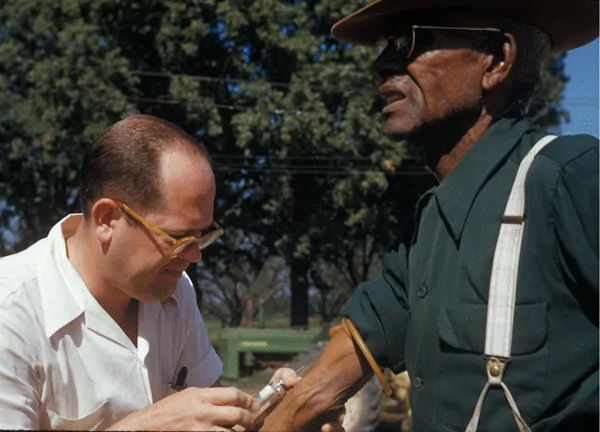 In the study, investigators enrolled a total of 600 impoverished African-American sharecroppers from Macon County, Alabama. Of these men, 399 had latent syphilis, with a control group of 201 men who were not infected. As an incentive for participation in the study, the men were promised free medical care, but were deceived by the PHS, who never informed subjects of their diagnosis and disguised placebos, ineffective methods, and diagnostic procedures as treatment.
In the study, investigators enrolled a total of 600 impoverished African-American sharecroppers from Macon County, Alabama. Of these men, 399 had latent syphilis, with a control group of 201 men who were not infected. As an incentive for participation in the study, the men were promised free medical care, but were deceived by the PHS, who never informed subjects of their diagnosis and disguised placebos, ineffective methods, and diagnostic procedures as treatment.- The men were initially told that the “study” was only going to last six months, but it was extended to 40 years.[5] After funding for treatment was lost, the study was continued without informing the men that they would never be treated. None of the infected men was treated with penicillin despite the fact that, by 1947, the antibiotic was widely available and had become the standard treatment for syphilis.
- 28 patients had died directly from syphilis, 100 died from complications related to syphilis, 40 of the patients’ wives were infected with syphilis, and 19 children were born with congenital syphilis.
- The 40-year Tuskegee Study was a major violation of ethical standards, and has been cited as “arguably the most infamous biomedical research study in U.S. history.” Its revelation led to the 1979 Belmont Report and to the establishment of the Office for Human Research Protections (OHRP) and federal laws and regulations requiring institutional review boards for the protection of human subjects in studies. The OHRP manages this responsibility within the United States Department of Health and Human Services (HHS).
- On May 16, 1997, President Bill Clinton formally apologized on behalf of the United States to victims of the study.
1916-Present – Porton Down UK
Reference: https://en.wikipedia.org/wiki/Porton_Down#Trials
A defense laboratory for chemical and biological weapons. It has a long history of informed consent violations and animal testing.
- 1942, Gruinard Island was dangerously contaminated with anthrax after a cloud of anthrax spores was released over the island during a trial.
- Between 1963 and 1975 the MRE carried out trials in Lyme Bay in which live bacteria were sprayed from a ship to be carried ashore by the wind to simulate an anthrax attack.
- Porton Down has been involved in human testing at various points throughout the Ministry of Defence’s use of the site. Up to 20,000 people took part in various trials from 1949 up to 1989.
- In 2002 a first inquest and in May 2004, a second inquest into the death of Ronald Maddison during testing of the nerve agent sarin commenced after his relatives and their supporters had lobbied for many years, which found his death to have been unlawful.
- In 2006, 500 veterans claimed they suffered from the experiments.
- In February 2006, three ex-servicemen were awarded compensation in an out-of-court settlement after they had claimed they were given LSD without their consent during the 1950s.
1955 St. Louis Neighborhood (possible) Radiation Testing
- The Army conducted secret chemical testing in her impoverished St. Louis neighborhood at the height of the Cold War.
- Army used motorized blowers atop a low-income housing high-rise, at schools and from the backs of station wagons to send a potentially dangerous compound into the already-hazy air in predominantly black areas of St. Louis.
- New research is raising greater concern about the implications of those tests. St. Louis Community College-Meramec sociology professor Lisa Martino-Taylor’s research has raised the possibility that the Army performed radiation testing by mixing radioactive particles with the zinc cadmium sulfide.
1951-1974 Holmesburg Prison Experiments
From approximately 1951 to 1974, the Holmesburg Prison in Pennsylvania was the site of extensive dermatological research operations, using prisoners as subjects. Led by Dr. Albert M. Kligman of the University of Pennsylvania, the studies were performed on behalf of Dow Chemical Company, the U.S. Army, and Johnson & Johnson. In one of the studies, for which Dow Chemical paid Kligman $10,000, Kligman injected dioxin — a highly toxic, carcinogenic compound which is found in Agent Orange, which Dow was manufacturing for use in Vietnam at the time — into 70 prisoners. A 1964 issue of Medical News reported that 9 out of 10 prisoners at Holmesburg Prison were medical test subjects. In 1967, the U.S. Army paid Kligman to apply skin-blistering chemicals to the faces and backs of inmates at Holmesburg, in Kligman’s words, “to learn how the skin protects itself against chronic assault from toxic chemicals, the so-called hardening process.”
Chemical Testing
- 1942-1944 – thousands of U.S. military personnel exposed to mustard gas.
- 1950-1953 – US Army sprayed chemicals over six cities in the United States and Canada, in order to test dispersal patterns of chemical weapons.
- Sulfuric Acid was fed to “Negro prisoners” by the Louisiana State Board of Health.
- 1953 experiment using 41 children to test cantharide.
1946-1973 Human Radiation Experiments
Researchers in the United States have performed thousands of human radiation experiments to determine the effects of atomic radiation and radioactive contamination on the human body, generally on people who were poor, sick, or powerless.[61] Most of these tests were performed, funded, or supervised by the United States military, Atomic Energy Commission, or various other U.S. federal government agencies.
The experiments included a wide array of studies, involving things like feeding radioactive food to mentally disabled children or conscientious objectors, inserting radium rods into the noses of schoolchildren, deliberately releasing radioactive chemicals over U.S. and Canadian cities, measuring the health effects of radioactive fallout from nuclear bomb tests, injecting pregnant women and babies with radioactive chemicals, and irradiating the testicles of prison inmates, amongst other things.
Much information about these programs was classified and kept secret. In 1986 the United States House Committee on Energy and Commerce released a report entitled American Nuclear Guinea Pigs : Three Decades of Radiation Experiments on U.S. Citizens.
Radioactive Iodine
In a 1949 operation called the “Green Run“, the U.S. Atomic Energy Commission (AEC) released iodine-131 and xenon-133 into the atmosphere near the Hanford site in Washington, which contaminated a 500,000-acre (2,000 km2) area containing three small towns.
1953 Radioactive Iodine on Newborns and Pregnant Women
In 1953, the AEC ran several studies at the University of Iowa on the health effects of radioactive iodine in newborns and pregnant women. In one study, researchers gave pregnant women between 100 to 200 microcuries (3.7 to 7.4 MBq) of iodine-131, in order to study the women’s aborted embryos in an attempt to discover at what stage, and to what extent, radioactive iodine crosses the placental barrier. In another study, they gave 25 newborn babies (who were under 36 hours old and weighed from 5.5 to 8.5 pounds (2.5 to 3.9 kg)) iodine-131, either by oral administration or through an injection, so that they could measure the amount of iodine in their thyroid glands, as iodine would go to that gland.
Iodine Given to Infants
AEC study, researchers at the University of Nebraska College of Medicine fed iodine-131 to 28 healthy infants through a gastric tube to test the concentration of iodine in the infants’ thyroid glands.
1953 Radioactive Iodine in Babies
In 1953, the AEC sponsored a study to discover if radioactive iodine affected premature babies differently from full-term babies. In the experiment, researchers from Harper Hospital in Detroit orally administered iodine-131 to 65 premature and full-term infants who weighed from 2.1 to 5.5 pounds (0.95 to 2.49 kg).
1955 Alaskan Eskimos Were Used to Study Radioactive Iodine
In Alaska, starting in August 1955, the AEC selected a total of 102 Eskimo natives and Athapascan Indians who would be used to study the effects of radioactive iodine on thyroid tissue, particularly in cold environments. Over a two year span, the test subjects were given doses of I-131 and samples of saliva, urine, blood, and thyroid tissue were collected from them. The purpose and risks of the radioactive iodine dosing, along with the collection of body fluid and tissue samples was not explained to the test subjects, and the AEC did not conduct any follow-up studies to monitor for long-term health effects.
1955-1960 Experiments on Mentally Disabled Children
From 1955 to 1960, Sonoma State Hospital in northern California served as a permanent drop-off location for mentally disabled children diagnosed with cerebral palsy or lesser disorders. The children subsequently underwent painful experimentation without adult consent. Many were given spinal taps “for which they received no direct benefit.” Reporters of 60 Minutes learned that in these five years, the brain of every child with cerebral palsy who died at Sonoma State was removed and studied without parental consent.
1960s Radioactive Iodine Experiments on Alaskan Citizens
In an experiment in the 1960s, over 100 Alaskan citizens were continually exposed to radioactive iodine.
1962 Hanford Radiation Experiments
In 1962, the Hanford site again released I-131, stationing test subjects along its path to record its effect on them. The AEC also recruited Hanford volunteers to ingest milk contaminated with I-131 during this time.
1946-1947 Uranium Kidney Experiments
Between 1946 and 1947, researchers at the University of Rochester injected uranium-234 and uranium-235 in dosages ranging from 6.4 to 70.7 micrograms per kilogram of body weight into six people to study how much uranium their kidneys could tolerate before becoming damaged.
1953-1957 Uranium Experiments on Hospital Patients
Between 1953 and 1957, at the Massachusetts General Hospital, Dr. William Sweet injected eleven terminally ill, comatose and semi-comatose patients with uranium in an experiment to determine, among other things, its viability as a chemotherapy treatment against brain tumors, which all but one of the patients had (one being a misdiagnosis). Dr. Sweet, who died in 2001, maintained that consent had been obtained from the patients and next of kin.
1945-1947 Plutonium Experiments
From April 10, 1945, to July 18, 1947, eighteen people were injected with plutonium as part of the Manhattan Project.
1945 “Cancer Treatment” With Plutonium Injections
Albert Stevens, a man misdiagnosed with stomach cancer, received “treatment” for his “cancer” at the U.C. San Francisco Medical Center in 1945. Dr. Joseph Gilbert Hamilton, a Manhattan Project doctor in charge of the human experiments in California,[72] had Stevens injected with Pu-238 and Pu-239 without informed consent. Stevens never had cancer; a surgery to remove cancerous cells was highly successful in removing the benign tumor, and he lived for another 20 years with the injected plutonium.[73] Since Stevens received the highly radioactive Pu-238, his accumulated dose over his remaining life was higher than anyone has ever received: 64 Sv (6400 rem). Neither Albert Stevens nor any of his relatives were told that he never had cancer; they were led to believe that the experimental “treatment” had worked.
Hospital Plutonium Injections
Three patients at Billings Hospital at the University of Chicago were injected with plutonium.[74] In 1946, six employees of a Chicago metallurgical lab were given water that was contaminated with plutonium-239 so that researchers could study how plutonium is absorbed into the digestive tract.
Plutonium Injection for Pituitary Gland Disorder
An eighteen-year-old woman at an upstate New York hospital, expecting to be treated for a pituitary gland disorder, was injected with plutonium.
Radioactive “Vitamin Drinks” Given to Pregnant Mothers
Immediately after World War II, researchers at Vanderbilt University gave 829 pregnant mothers in Tennessee what they were told were “vitamin drinks” that would improve the health of their babies. The mixtures contained radioactive iron and the researchers were determining how fast the radioisotope crossed into the placenta. At least three children are known to have died from the experiments, from cancers and leukemia.[76][77] Four of the women’s babies died from cancers as a result of the experiments, and the women experienced rashes, bruises, anemia, hair/tooth loss, and cancer.
1946 – 1953 Radioactive Oatmeal Given to Mentally Disabled Children
From 1946 to 1953, at the Walter E. Fernald State School in Massachusetts, in an experiment sponsored by the U.S. Atomic Energy Commission and the Quaker Oats corporation, 73 mentally disabled children were fed oatmeal containing radioactive calcium and other radioisotopes, in order to track “how nutrients were digested”. The children were not told that they were being fed radioactive chemicals; they were told by hospital staff and researchers that they were joining a “science club”.
San Francisco Hospital Irradiates Patients
The University of California Hospital in San Francisco exposed 29 patients, some with rheumatoid arthritis, to total body irradiation (100-300 rad dose) to obtain data for the military.
1950s Burn and Radiation Experiments
In the 1950s, researchers at the Medical College of Virginia performed experiments on severe burn victims, most of them poor and black, without their knowledge or consent, with funding from the Army and in collaboration with the AEC. In the experiments, the subjects were exposed to additional burning, experimental antibiotic treatment, and injections of radioactive isotopes. The amount of radioactive phosphorus-32 injected into some of the patients, 500 microcuries (19 MBq), was 50 times the “acceptable” dose for a healthy individual; for people with severe burns, this likely led to significantly increased death rates.
1948-1954 Johns Hopkins Hospital Nasal Radium Radiation
Between 1948 and 1954, funded by the federal government, researchers at the Johns Hopkins Hospital inserted radium rods into the noses of 582 Baltimore, Maryland schoolchildren as an alternative to adenoidectomy.[84][85][86] Similar experiments were performed on over 7,000 U.S. Army and Navy personnel during World War II.[84] Nasal radium irradiation became a standard medical treatment and was used in over two and a half million Americans.
1956 Radioactive Calcium Injected Into Mentally Disabled Children
In another study at the Walter E. Fernald State School, in 1956, researchers gave mentally disabled children radioactive calcium orally and intravenously. They also injected radioactive chemicals into malnourished babies and then collected cerebrospinal fluid for analysis from their brains and spines.
1961-1962 Utah State Prison Radiation Experiment
In 1961 and 1962, ten Utah State Prison inmates had blood samples taken which were mixed with radioactive chemicals and reinjected back into their bodies.
1961-1965 Thorium Radiation Injections
The U.S. Atomic Energy Commission funded the Massachusetts Institute of Technology to administer radium-224 and thorium-234 to 20 people between 1961 and 1965. Many were chosen from the Age Center of New England and had volunteered for “research projects on aging”.
1967 Pregnant Women Irradiated
In a 1967 study that was published in the Journal of Clinical Investigation, pregnant women were injected with radioactive cortisol to see if it would cross the placental barrier and affect the fetuses.
Fallout Research
In 1957, atmospheric nuclear explosions in Nevada, which were part of Operation Plumbbob were later determined to have released enough radiation to have caused from 11,000 to 212,000 excess cases of thyroid cancer among U.S. citizens who were exposed to fallout from the explosions, leading to between 1,100 and 21,000 deaths.
1960-1971 Whole Body Radiation Experiments on Poor and Black Cancer Patients
Between 1960 and 1971, the Department of Defense funded non-consensual whole body radiation experiments on mostly poor and black cancer patients, who were not told what was being done to them. Patients were told that they were receiving a “treatment” that might cure their cancer, but the Pentagon was trying to determine the effects of high levels of radiation on the human body. One of the doctors involved in the experiments was worried about litigation by the patients. He referred to them only by their initials on the medical reports. He did this so that, in his words, “there will be no means by which the patients can ever connect themselves up with the report”, in order to prevent “either adverse publicity or litigation”.
1963-1973 Irradiation of Prisoners
From 1963 to 1973, a leading endocrinologist, Dr. Carl Heller, irradiated the testicles of Oregon and Washington prisoners. In return for their participation, he gave them $5 a month, and $100 when they had to receive a vasectomy upon conclusion of the trial. The surgeon who sterilized the men said that it was necessary to “keep from contaminating the general population with radiation-induced mutants“. Dr. Joseph Hamilton, one of the researchers who had worked with Heller on the experiments, said that the experiments “had a little of the Buchenwald touch”.
1963 Irradiation of More Prisoners
In 1963, University of Washington researchers irradiated the testicles of 232 prisoners to determine the effects of radiation on testicular function. When these inmates later left prison and had children, at least four of them had offspring born with birth defects. The exact number is unknown because researchers never followed up on the status of the subjects.
1966 US Army Bacteria Release in New York Subway System
In 1966, the U.S. Army released Bacillus globigii into the tunnels of the New York City Subway system, as part of a field experiment called A Study of the Vulnerability of Subway Passengers in New York City to Covert Attack with Biological Agents. The Chicago subway system was also subject to a similar experiment by the Army.
1963-1969 US Army Biological Warfare Experiments
From 1963 to 1969 as part of Project Shipboard Hazard and Defense (SHAD), the U.S. Army performed tests which involved spraying several U.S. ships with various biological and chemical warfare agents, while thousands of U.S. military personnel were aboard the ships. The personnel were not notified of the tests, and were not given any protective clothing. Chemicals tested on the U.S. military personnel included the nerve gases VX and Sarin, toxic chemicals such as zinc cadmium sulfide and sulfur dioxide, and a variety of biological agents.
1963 Injection of Live Cancer Cells into Elderly Patients
In 1963, 22 elderly patients at the Jewish Chronic Disease Hospital in Brooklyn, New York City were injected with live cancer cells by Chester M. Southam, who in 1952 had done the same to prisoners at the Ohio State Prison, in order to “discover the secret of how healthy bodies fight the invasion of malignant cells”. The administration of the hospital attempted to cover the study up, but the New York medical licensing board ultimately placed Southam on probation for one year. Two years later, the American Cancer Society elected him as their vice president.
1955 Mosquito Experiments
In May 1955 over 300,000 uninfected mosquitoes (Aedes aegypti) were dropped over parts of the U.S. state of Georgia to determine if the air-dropped mosquitoes could survive to take meals from humans. The mosquito tests were known as Operation Big Buzz. The U.S. engaged in at least two other EW testing programs, Operation Drop Kick and Operation May Day.
1954 Fleas as Weapons
Operation Big Itch, in 1954, was designed to test munitions loaded with uninfected fleas (Xenopsylla cheopis).
1979 CIA Whooping Cough
It was alleged that the CIA conducted open air biological warfare experiments in 1955 near Tampa, Florida using whooping cough bacteria, possibly being the reason behind > 1000 cases of whooping cause (deaths went from 1 to 12 over the previous year). https://en.wikipedia.org/wiki/Unethical_human_experimentation_in_the_United_States
1953-1963 CIA LSD Experiments (MK-ULTRA)
 In 1953, Dr. Frank Olson and several other colleagues were unknowingly dosed with LSD as part of a CIA experiment. Olson died nine days later after falling to his death from a hotel window under suspicious circumstances.
In 1953, Dr. Frank Olson and several other colleagues were unknowingly dosed with LSD as part of a CIA experiment. Olson died nine days later after falling to his death from a hotel window under suspicious circumstances.
MK-Ultra’s “mind control” experiments generally centered around behavior modification via electro-shock therapy, hypnosis, polygraphs, radiation, and a variety of drugs, toxins, and chemicals. MK-Ultra’s programs often preyed on the most vulnerable members of society. The CIA considered prisoners especially good subjects, as they were willing to give consent in exchange for extra recreation time or commuted sentences. Source: The CIA’s Appalling Human Experiments With Mind Control
1952 Injection of Live Cancer Cells into Prisoners
In 1952, Chester M. Southam, a Sloan-Kettering Institute researcher, injected live cancer cells, known as HeLa cells, into prisoners at the Ohio State Penitentiary and cancer patients. Also at Sloan-Kettering, 300 healthy females were injected with live cancer cells without being told. The doctors stated that they knew at the time that it might cause cancer.
1950s-1972 Hepatitis Infection of Mentally Disabled Children
From the 1950s to 1972, mentally disabled children at the Willowbrook State School in Staten Island, New York, were intentionally infected with viral hepatitis, for research whose purpose was to help discover a vaccine. From 1963 to 1966, Saul Krugman of New York University promised the parents of mentally disabled children that their children would be enrolled into Willowbrook in exchange for signing a consent form for procedures that he claimed were “vaccinations”. In reality, the procedures involved deliberately infecting children with viral hepatitis by feeding them an extract made from the feces of patients infected with the disease.
1950-1969+ US Navy Serratia tests over San Francisco
In 1950, in order to conduct a simulation of a biological warfare attack, the U.S. Navy sprayed large quantities of the bacteria Serratia marcescens – considered harmless at the time – over the city of San Francisco during a project called Operation Sea-Spray. Numerous citizens contracted pneumonia-like illnesses, and at least one person died as a result. The family of the person who died sued the government for gross negligence, but a federal judge ruled in favor of the government in 1981. Serratia tests were continued until at least 1969.
1950 Viral Hepatitis Infection of Female Prisoners
Dr. Joseph Stokes of the University of Pennsylvania deliberately infected 200 female prisoners with viral hepatitis.
1946-1948 Guatemala syphilis experiments
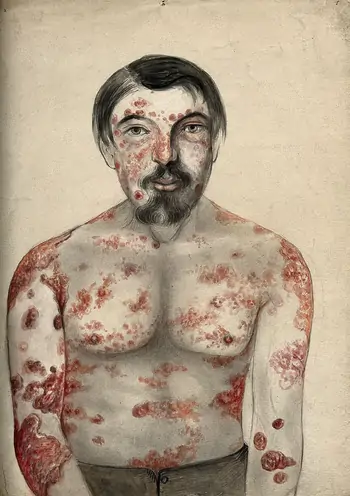 The Guatemala syphilis experiments (1946-1948) were United States-led human experiments conducted in Guatemala from 1946 to 1948. The experiments were led by physician John Charles Cutler who also participated in the late stages of the Tuskegee syphilis experiment. Doctors infected soldiers, prostitutes, prisoners and mental patients with syphilis and other sexually transmitted diseases, without the informed consent of the subjects. The experiment resulted in at least 83 deaths.[1] Serology studies continued through 1953 involving the same vulnerable populations in addition to children from state-run schools, an orphanage, and rural towns, though the intentional infection of patients ended with the original study. On October 1, 2010, the U.S. President, Secretary of State and Secretary of Health and Human Services[2] formally apologized to Guatemala for the ethical violations that took place.
The Guatemala syphilis experiments (1946-1948) were United States-led human experiments conducted in Guatemala from 1946 to 1948. The experiments were led by physician John Charles Cutler who also participated in the late stages of the Tuskegee syphilis experiment. Doctors infected soldiers, prostitutes, prisoners and mental patients with syphilis and other sexually transmitted diseases, without the informed consent of the subjects. The experiment resulted in at least 83 deaths.[1] Serology studies continued through 1953 involving the same vulnerable populations in addition to children from state-run schools, an orphanage, and rural towns, though the intentional infection of patients ended with the original study. On October 1, 2010, the U.S. President, Secretary of State and Secretary of Health and Human Services[2] formally apologized to Guatemala for the ethical violations that took place.
President Barack Obama apologized to President Álvaro Colom, who had called the experiments “a crime against humanity”.
- Wikipedia entry: https://en.wikipedia.org/wiki/Guatemala_syphilis_experiments (warning: Wikipedia is known to have severe bias)
1944-1946 Illinois State Hospital Malaria Experiments
From 1944 to 1946, Dr. Alf Alving, a nephrologist and professor at the University of Chicago Medical School, purposely infected psychiatric patients at the Illinois State Hospital with malaria so that he could test experimental treatments on them.
source: https://en.wikipedia.org/wiki/Unethical_human_experimentation_in_the_United_States
Forced Sterilization (1890-1920)
- The USA was the first country to undertake forced sterilization for the purposes of eugenics.
- The principal targets of the American sterilization programs were the intellectually disabled and the mentally ill, but also targeted under many state laws were the deaf, the blind, people with epilepsy, and the physically deformed.
- Some sterilizations took place in prisons and other penal institutions, targeting criminality, but they were in the relative minority.
- In the end, over 65,000 individuals were sterilized in 33 states under state compulsory sterilization programs in the United States, in all likelihood without the perspectives of ethnic minorities.
- The first state to introduce a compulsory sterilization bill was Michigan, in 1897, but the proposed law failed to pass.
- Eight years later Pennsylvania’s state legislators passed a sterilization bill that was vetoed by the governor.
- Indiana became the first state to enact sterilization legislation in 1907, followed closely by California and Washington in 1909.
- Several other states followed, but such legislation remained controversial enough to be defeated in some cases, as in Wyoming in 1934.
- In the 1920s, Eugenicists were particularly interested in black women in the South and Latina women in the Southwest in order to break the chain of welfare dependency and curb the population rise of non-white citizens.
- Between 1970 and 1976, Indian Health Services sterilized between 25 and 42 percent of women of reproductive age who came in seeking healthcare services.
- A significant number of sterilizations continued in a few states through the 1970s.
- In California, ten women who delivered their children at LAC-USC hospital between 1971-1974 and were sterilized without proper consent sued the hospital in the landmark Madrigal v. Quilligan case in 1975.
- The consent process were made following the ruling, such as offering consent forms in the patient’s native language, and a 72-hour waiting period between giving consent and undergoing the procedure.
- The Oregon Board of Eugenics, later renamed the Board of Social Protection, existed until 1983, with the last forcible sterilization occurring in 1981.
- The U.S. commonwealth Puerto Rico had a sterilization program as well.
- Some states continued to have sterilization laws on the books for much longer after that, though they were rarely if ever used. California sterilized more than any other state by a wide margin, and was responsible for over a third of all sterilization operations.
- Poe v. Lynchburg Training School & Hospital (1981), was filed in the courts on the grounds that the sterilization law was unconstitutional. It was rejected because the law was no longer in effect at the time of the filing.
- The 27 states where sterilization laws remained on the books (though not all were still in use) in 1956 were: Arizona, California, Connecticut, Delaware, Georgia, Idaho, Indiana, Iowa, Kansas, Maine, Michigan, Minnesota, Mississippi, Montana, Nebraska, New Hampshire, North Carolina, North Dakota, Oklahoma, Oregon, South Carolina, South Dakota, Utah, Vermont, Virginia, Washington, West Virginia and Wisconsin.
- North Carolina sterilized 7,600 people from 1929 to 1974 who were deemed socially or mentally unfit.
- Georgia – United States in 2020. Reports show that illegal hysterectomies were performed in Georgia on immigrants at Immigration and Customs Enforcement’s Irwin County center. The physicians who performed the unnecessary hysterectomy believe that they do not have as much knowledge or authority over themselves due to the women being immigrants. The woman who remained anonymous claimed that she complained to Irwin that the physician Mahendra Amin were performing nonconsensual and invasive procedures. Despite him denying any of the allegations against himself, his case is still an ongoing federal investigation. This shows that compulsory sterilization is still present in the United States as of today. After continuing the physician’s investigation, one of the nurses named Dawn Wooten came out saying that she felt that this same physician was performing compulsory sterilization. This called for an independent team of medical experts plus nine board-certified OB’s to review more than 3,200 pages of medical records from 19 women that Irwin unnecessarily performed hysterectomies on. Afterward, they found a pattern of inadequate misdiagnosing and failure to secure informed consent for surgery and other procedures. Nothing has been done for the women who have been forcibly sterilized, but one woman stated that she hopes President Joe Biden will do something about Irwin’s actions.
- In 2020, multiple human rights groups joined a whistleblower to accuse a private-owned U.S. immigration detention center in Georgia of forcibly sterilizing women.
- A doctor conducted unauthorized medical procedures on women detained by Immigration and Customs Enforcement.
- A whistleblower claims a high rate of sterilizations were performed on Spanish-speaking women and women who spoke various Indigenous languages common in Latin America. Wooten said the center did not obtain proper consent for these surgeries, or lied to women about the medical procedures.
- More than 40 women submitted testimony in writing to document these abuses, one attorney said.
- Legal case: BUCK v. BELL, Superintendent of State Colony Epileptics and Feeble Minded.
Reference: https://en.wikipedia.org/wiki/Compulsory_sterilization#United_States
Lobotomy
- The USSR officially banned the procedure in 1950. Doctors in the Soviet Union concluded that the procedure was “contrary to the principles of humanity” and “‘through lobotomy’ an insane person is changed into an idiot”.
- By the 1970s, numerous countries had banned the procedure, as had several US states.
- In 1977 the US Congress created the National Committee for the Protection of Human Subjects of Biomedical and Behavioral Research to investigate allegations that psychosurgery – including lobotomy techniques – was used to control minorities and restrain individual rights.
Reference: https://en.wikipedia.org/wiki/Lobotomy
Electroconvulsive therapy
- A national audit of ECT by the Scottish ECT Accreditation Network indicated that 77% of patients who received the treatment in 2008 were capable of giving informed consent.
- A 2005 study published in the British Journal of Psychiatry described patients’ perspectives on the adequacy of informed consent before ECT.[133] The study found that “About half (45–55%) of patients reported they were given an adequate explanation of ECT, implying a similar percentage felt they were not.” The authors also stated:
- Approximately a third did not feel they had freely consented to ECT even when they had signed a consent form. The proportion who feel they did not freely choose the treatment has actually increased over time. The same themes arise whether the patient had received treatment a year ago or 30 years ago. Neither current nor proposed safeguards for patients are sufficient to ensure informed consent with respect to ECT, at least in England and Wales.[133]
- In 1908, three Philadelphia researchers infected dozens of children with tuberculin at St. Vincent Orphanage in Philadelphia, Pennsylvania, causing permanent blindness in some of the children and painful lesions and inflammation of the eyes in many of the others. In the study, they refer to the children as “material used”.
- In 1909, Frank Crazier Knowles published a study in the Journal of the American Medical Association describing how he had deliberately infected two children in an orphanage with Molluscum contagiosum—a virus that causes wart-like growths but usually disappears entirely—after an outbreak in the orphanage, in order to study the disease.
- In 1911, Dr. Hideyo Noguchi of the Rockefeller Institute for Medical Research in Manhattan, New York City injected 146 hospital patients (some of whom were children) with a syphilis extract. He was later sued by the parents of some of the child subjects, who allegedly contracted syphilis as a result of his experiments.
- Source: https://en.wikipedia.org/wiki/Unethical_human_experimentation_in_the_United_States
1941 Influenza Experiment
In 1941, at the University of Michigan, virologists Thomas Francis, Jonas Salk and other researchers deliberately infected patients at several Michigan mental institutions with the influenza virus by spraying the virus into their nasal passages. source: https://en.wikipedia.org/wiki/Unethical_human_experimentation_in_the_United_States
1941 Baby Inoculated with Herpes
In 1941 Dr. William C. Black inoculated a twelve-month-old baby with herpes who was “offered as a volunteer”. He submitted his research to the Journal of Experimental Medicine which rejected the findings due to the ethically questionable research methods used in the study. Rous called the experiment “an abuse of power, an infringement of the rights of an individual, and not excusable because the illness which followed had implications for science.”[28][29][30] The study was later published in the Journal of Pediatrics.[31] source: https://en.wikipedia.org/wiki/Unethical_human_experimentation_in_the_United_States
Statesville Penitentiary Malaria Study
The Stateville Penitentiary Malaria Study was a controlled study of the effects of malaria on the prisoners of Stateville Penitentiary near Joliet, Illinois, beginning in the 1940s. The study was conducted by the Department of Medicine (now the Pritzker School of Medicine) at the University of Chicago in conjunction with the United States Army and the U.S. State Department. At the Nuremberg trials, Nazi doctors cited the precedent of the malaria experiments as part of their defense.[32][33] The study continued at Stateville Penitentiary for 29 years.
source: https://en.wikipedia.org/wiki/Unethical_human_experimentation_in_the_United_States
National Socialist Medical Experiments
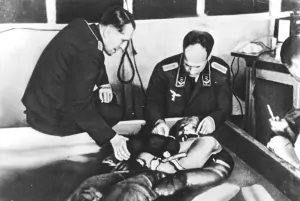 Large numbers of prisoners, including children, by Nazi Germany in its concentration camps in the early to mid 1940s, during World War II and the Holocaust. Chief target populations included Romani, Sinti, ethnic Poles, Soviet POWs, disabled Germans, and Jews from across Europe.
Large numbers of prisoners, including children, by Nazi Germany in its concentration camps in the early to mid 1940s, during World War II and the Holocaust. Chief target populations included Romani, Sinti, ethnic Poles, Soviet POWs, disabled Germans, and Jews from across Europe.- Nazi physicians and their assistants forced prisoners into participating; they did not willingly volunteer and no consent was given for the procedures. Typically, the experiments were conducted without anesthesia and resulted in death, trauma, disfigurement, or permanent disability, and as such are considered examples of medical torture.
- At Auschwitz and other camps, under the direction of Eduard Wirths, selected inmates were subjected to various experiments that were designed to help German military personnel in combat situations, develop new weapons, aid in the recovery of military personnel who had been injured, and to advance the Nazi racial ideology and eugenics, including the twin experiments of Josef Mengele. Aribert Heim conducted similar medical experiments at Mauthausen.
- Experiments included:
- Experiments on twins
- Bone, muscle, and nerve transplantation experiments
- Head injury experiments
- Freezing experiments
- Malaria experiments
- Immunization experiments
- Epidemic jaundice
- Mustard gas experiments
- Sulfonamide experiments
- Sea water experiments
- Sterilization and fertility experiments
- Experiments with poison
- Incendiary bomb experiments
- High altitude experiments
- Blood coagulation experiments
- Electroshock experiments
- This precipitated the Nuremberg Trials and the development of the Nuremberg Code.
Source: https://en.wikipedia.org/wiki/Nazi_human_experimentation


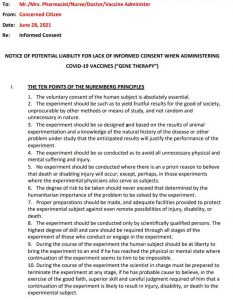
 December 11, 2021
December 11, 2021
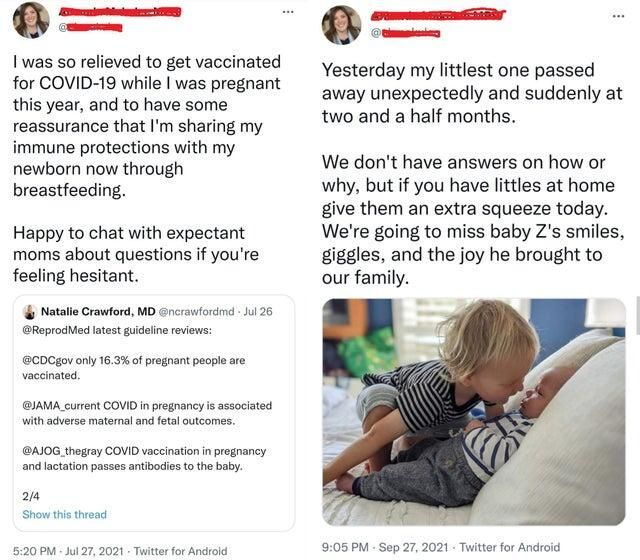 December 10, 2021
December 10, 2021
 December 10, 2021
December 10, 2021
 December 6, 2021
December 6, 2021
 December 3, 2021
December 3, 2021
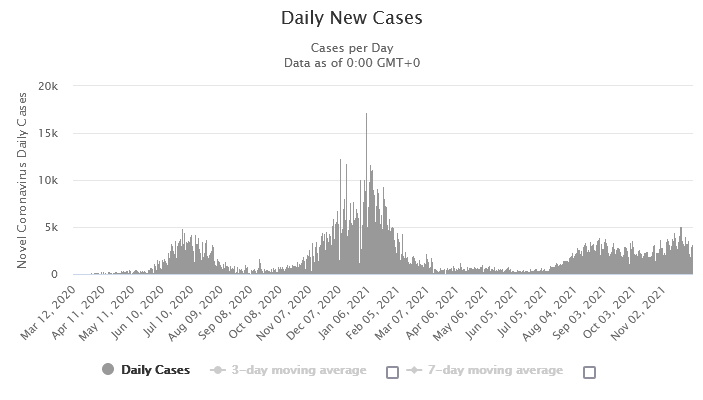 December 3, 2021
December 3, 2021
 December 3, 2021
December 3, 2021